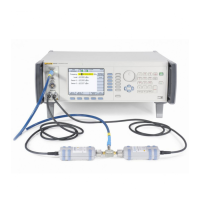Maintenance
Running Self-Test 5
5-25
Interpreting the Results
The failure information on the display can assist with isolating a problem to a
given PCA. For example, in a case where a single failure occurs, the code letter
in the test point name (S, A, H, or M) will indicate which assembly is most likely
to be the source of the problem. (See Test Point Name encoding in Table 5-2.)
However, in cases where multiple assemblies show failures, isolating the
problem is less straightforward. In these cases it can be helpful to refer to
Chapter 2, Theory of Operation to help isolate the faulty assembly. For example,
one failure on the Synthesizer PCA and several failures on the RF Output PCA
could indicate that a satisfactory signal is not leaving the Synthesizer PCA. As a
result, tests on the RF Output PCA will naturally fail. In this case, the Synthesizer
PCA test point description in the box would help isolate the source of the
problem.
The Synthesizer PCA test failures relating to a single power supply are likely to
be caused by the Synthesizer PCA itself, whereas failure of the majority of
supplies can indicate a fault with the Power Supply PCA.
Failures of the Leveling Head can be caused by faults on the RF Output PCA. To
determine if a Leveling Head is at fault, plug it into a known good Base and test it
again.
Tests are performed in a sequence which, where possible, tests one aspect of
functionality before testing dependent functions. When multiple failures are
reported, the earlier failures are more likely to be indicative of the true source of a
problem.
Most tests operate by measuring a dc voltage at an indicated point. In many
cases, the test description indicates that a specific frequency and/or amplitude of
signal is being routed through a particular section of circuitry which results in the
voltage being measured. In some cases, the test also checks to ensure specific
phase-locked loops are locked. Some other tests will not involve measuring a
voltage, but will instead be doing a more complex algorithmic check (for example,
a memory test).
Some of the tests, identified by a test name containing the letter M in the
schematic sequence number (for example, S01.M01) are math tests. These math
tests compare results of two or more other tests. Math tests allow properties that
cannot be directly measured to be tested. If the tests, on which the calculations
are based, have failed, the associated math test(s) will also fail.
As part of the self-test operation, the unit enters operating modes not directly
accessible as part of the normal functioning of the unit. Self-test failures at
specific frequencies and/or amplitudes should not be taken to imply the unit will
operate correctly outside these areas in normal use.
Some problems cannot be detected or diagnosed with self test alone and can
require additional manual testing with external equipment.

